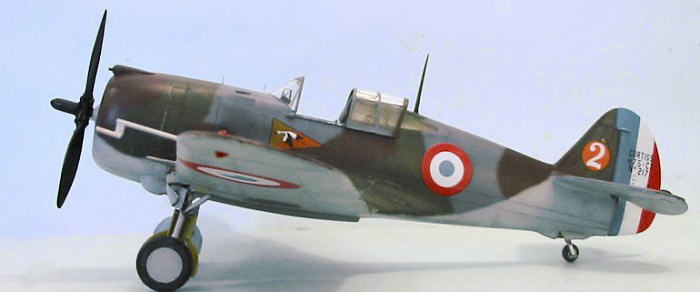
| KIT #: | 3245 |
| PRICE: | £31.48 from www.hannants.co.uk (around USD $58) |
| DECALS: | Three options |
| REVIEWER: | Tom Cleaver |
| NOTES: | Short run with resin parts |

| HISTORY |
Quick: what airplane shot down the first German aircraft on the Western Front in World War II?
I’ll bet you didn’t say “The Curtiss Hawk 75.” But that’s the correct answer. The first German aircraft lost on the Western Front were two Bf-109E-3s shot down by Hawk 75A-1s of GC II/4 on September 8, 1939. Though only 1,100 Hawk 75s of all types were produced between 1937-41, the aircraft was used on all operational fronts against all three Axis powers at one time or another, and was flown by air forces on both sides!
Though the Hawk 75 series is commonly thought of as something of a failure, it
was recalled with pleasure by both Erik Shilling and Kyosti Karhila - the
ranking Finnish Hawk 75 ace - in interviews with me. Steve Hinton, who is the
only contemporary pilot to have flown the Hawk 75, P-40B, P-40E and P-40N, says
that the Hawk 75 has the best handling characteristics of any of the P-36/P-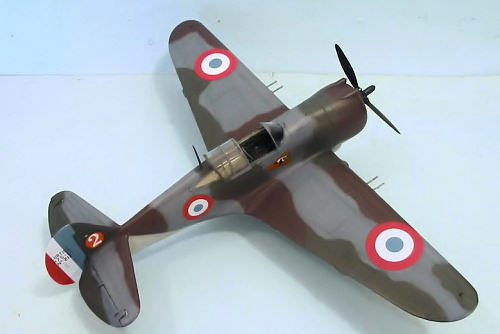 40series,
with finger-light controls and excellent maneuverability. Kyosti Karhila, who
shot down 14 enemy aircraft while flying a Hawk 75A-3 for two years on the
Eastern Front, said “the only problem was it wasn’t fast enough.”
40series,
with finger-light controls and excellent maneuverability. Kyosti Karhila, who
shot down 14 enemy aircraft while flying a Hawk 75A-3 for two years on the
Eastern Front, said “the only problem was it wasn’t fast enough.”
Don Berliner, Chief Designer of Curtiss-Wright, first set pencil to paper to create the Hawk 75 in 1934, the same year that saw the birth of the Messerschmitt Bf-109, the Hawker Hurricane and the Supermarine Spitfire. The design was as revolutionary for Curtiss - at the time the premier supplier of fighter aircraft to the U.S. Army Air Corps and the U.S. Navy - as were the other designs for their respective creators. It was the first all-metal, retractable-gear, enclosed-cockpit fighter produced by Curtiss. While the XP-36 lost the 1937 Fighter Competition to the Seversky P-35, the P-36 came back - powered by a better engine - to obtain the largest production order from the Army for a fighter since the First World War, and went on to spawn the P-40.
Curtiss had always been known for maximizing the export potential of their designs, and the Hawk 75 was no exception.
The French Air Force found itself after the Munich Crisis in the unenviable position of having two of its most advanced fighter designs fail to achieve their performance goals at the moment they were needed most. While the prices quoted by Curtiss were nearly twice what the French thought the fighter was worth, and was more than twice as expensive as domestic designs, it had the benefit of being proven and available. Curtiss convinced the French Government to invest in a second factory in Buffalo to insure promised delivery dates, and began delivering the Hawk 75A-1 - equivalent of the USAAC P-36C Hawk - in the Spring of 1939. By the time France surrendered a year later, 320 Hawk 75A-1, A-2 and A-3 aircraft had been delivered to the Armee de l’Air.
Numerically second to the Morane-Saulnier M.S. 406, the Hawk 75 equipped four
Groupes de Chasse at the time of the German invasion on May 10, 1940. The
pilots immediately discovered their airplane was inferior to the Bf-109E on all
counts other than 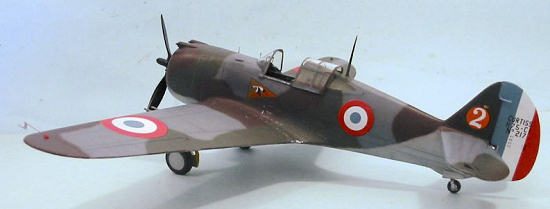 maneuverability
and airframe strength, with the Bf-109E able to break off combat at will due to
its appreciably higher speed, though the Hawk proved able to take punishment and
still get home. French Hawk pilots shot down over 150 German aircraft in the
five weeks they fought the Luftwaffe.
maneuverability
and airframe strength, with the Bf-109E able to break off combat at will due to
its appreciably higher speed, though the Hawk proved able to take punishment and
still get home. French Hawk pilots shot down over 150 German aircraft in the
five weeks they fought the Luftwaffe.
Czech Ace Frantisek Perina, who flew the Hawk 75A-3 with GC I/5 during the Battle of France, remembers the Hawk 75 as being “terrific.” “It was not as fast as the Messerschmitt, but it could outmaneuver any German aircraft. If one got on your tail, in one 360-degree turn you were behind him.”
By November 1942, the Hawk 75A-3s of GC II/5, the Lafayette Escadrille, were one of three Hawk 75 units based in Morocco, outside Rabat on the Atlantic coast. On November 8, 1942, American forces began to invade French Morocco, and the Hawk 75s engaged in combat with Grumman F4F-4 Wildcats of VF-9 and VF-41 for two days. 15 Hawks were lost in combat while the French shot down 7 Wildcats. Following the Armistice, the French units were re-equipped with more modern aircraft, with GC II/5 exchanging their Hawk 75s for its descendant, the P-40F Warhawk. The Hawk75s remained in service as fighter trainers until 1947.
In the hard school of war, the Hawk 75 proved to be mediocre, despite many admirable qualities. Although inferior in performance to the majority of its opponents, it was tractable and sturdy, and its war record brought it no shame.
Marin la Meslée: The French Ace of Aces in the Battle of France
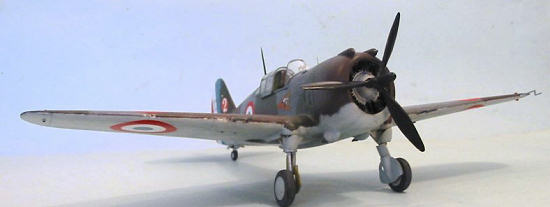 Lieutenant Edmond Marin
la Meslée of GC I/5 was the French Ace of Aces during the Battle of France.
With 16 victories and 4 probables, he is the ranking ace in the Hawk 75 of any
pilot in any air force.
Lieutenant Edmond Marin
la Meslée of GC I/5 was the French Ace of Aces during the Battle of France.
With 16 victories and 4 probables, he is the ranking ace in the Hawk 75 of any
pilot in any air force.
Born in Valenciennes on February 5, 1912, Meslée entered law school in 1931 to please his family. Taking advantage of a government aviation program, he learned to fly at the Morane flight school, obtaining his pilot license August 11, 1931. Shortly thereafter, he volunteered for two years’ service and entered the French Air Force school at Istres. After graduation, he was sent to the 2nd Fighter Regiment in Strasbourg with the rank of Second Lieutenant. In 1934, with his enlistment about to expire, he re-enlisted for two more years, but had to take a reduction in rank to Sergeant.
In October 1937, he was admitted to the French Air Force Academy and promoted again to Second Lieutenant upon graduation in 1939. He was then assigned to GC I/5, where Commanding Officer Captain Jacques Accart recognized his potential as a fighter pilot.
During the Phoney War period, Meslée shot down a Do 17 on January 11, 1940. He entered combat on May 11, the day after the German attack in the West began, shooting down 3 German aircraft that day. He shot down one aircraft each on May 13, 15 and 16, three on May 18, with six more by June 10. On June 11, 1940, Accart was wounded in combat and Meslée took his place as the leader of the 1st Escadrille.
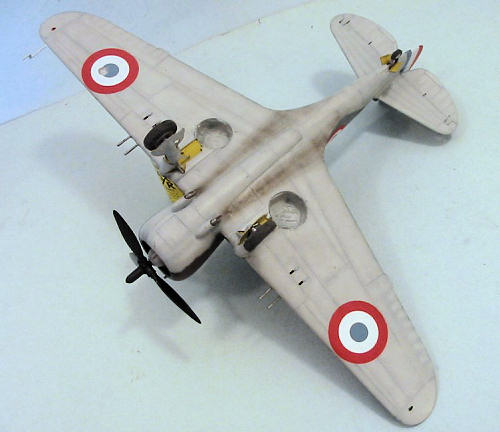 GC I/5 remained in
combat until June 25, when the unit evacuated to North Africa. GC I/5 downed 117
German aircraft, losing only four pilots, one of whom died of blood poisoning
while in the hospital, and had the best record of any fighter unit in the
Armeé de l'Air during the Battle of France.
GC I/5 remained in
combat until June 25, when the unit evacuated to North Africa. GC I/5 downed 117
German aircraft, losing only four pilots, one of whom died of blood poisoning
while in the hospital, and had the best record of any fighter unit in the
Armeé de l'Air during the Battle of France.
Meslée remained with the unit through the Vichy period. After the Allied invasion of North Africa, he led the unit in joining the Allies. They were first provided P-40s, then P-39s in the summer of 1943, carrying out patrols over the Mediterranean. He was promoted as Commandant of GC 1/5 Champagne on January 9, 1944. Re-equipping with the P-47 Thunderbolt that fall, they were transferred to Salon-de-Provence on September 30 to support the French and Allied forces pursuing the Germans along the Rhône River.
On December 29, the group moved on to Dôle during the fighting in the Colmar Pocket. Meslée was supposed to retire from active combat flying in February 1945, but insisted on going on one final mission.
On February 4, 1945, he flew as leader of a three-plane patrol, with Captain Rouquette leading two other Thunderbolts to provide top cover. Meslée’s three P-47s attacked a temporary bridge near Neuf Brisach. After this attack, Meslée spotted a German truck column. Despite intense flak, he strafed the convoy. Returning to verify the results, he was hit by a 40 mm shell behind the armor plate. Mortally wounded with shrapnel in his neck, Meslée’s P-47 crashed and exploded at Rustenhart. Chief-Sergeant Uhry was also hit killed by flak, his P-47 crashing near that of his leader.
Meslée was buried where he crashed, memorialized with a marker in the shape of a French pilot’s badge. With his fellow French pilots, Edmond Marin la Meslée flew in the tradition of Guynemer and Fonck.
| THE KIT |
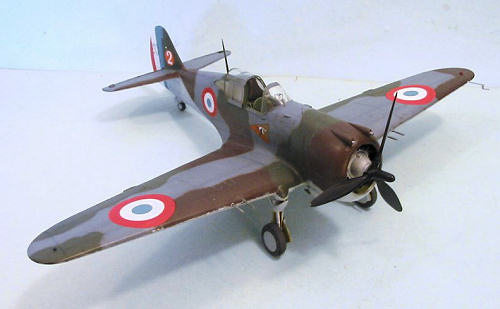 Following their P-36A
released last November, Azur has released this kit which can be built as the
Hawk 75A-1 or A-2/A-3, which are visually differentiated by the number of guns
in the wings (1 each for the A-1, 2 each for the A-2/A-3).
Following their P-36A
released last November, Azur has released this kit which can be built as the
Hawk 75A-1 or A-2/A-3, which are visually differentiated by the number of guns
in the wings (1 each for the A-1, 2 each for the A-2/A-3).
This kit differs from the previous kit primarily in having detailed resin parts for the cockpit. While some of these parts are really good and add to the overall look of the final model, some of them are not that much superior to the original plastic parts, and in fact the plastic parts fit better. A pre-painted photo-etch instrument panel is also provided, along with seat belts and other cockpit details in photo-etch.
Decals are provided for three Hawk 75s, including the Hawk 75A-3 flown by Edmond Marin la Meslée.
| CONSTRUCTION |
The kit breaks down into three major sub-assemblies: the engine and cowling, the main fuselage with cockpit, and the wings.
One must remember that this kit is produced by MPM, which still operates on the theory of “Fit? Fit?? We don’t need no steenking fit!!!” This is particularly true for the resin parts, most of which appear to have been designed for another Hawk 75 by a different company in a different scale, the fit is that bad. That said, the good parts are quite good and very useful.
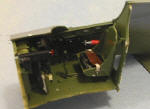 While I used all the resin parts, I would say in retrospect that only the side
panels and the seat - which is much better detailed than the plastic seat - are
really necessary. While the forward cockpit bulkhead has a great deal of
detail, none of it is visible once the fuselage is assembled, and it does not
fit as well as the original plastic part, leading to later difficulties when it
comes to mating the fuselage sub assembly to the wing and engine sub-assembly.
The resin seat rack is worthless, and the rear bulkhead also does not fit as
well as the original part. The resin cockpit floor is indistinguishable in
detail from the plastic part, and is also more curved than the plastic part,
leading to poor fit.
While I used all the resin parts, I would say in retrospect that only the side
panels and the seat - which is much better detailed than the plastic seat - are
really necessary. While the forward cockpit bulkhead has a great deal of
detail, none of it is visible once the fuselage is assembled, and it does not
fit as well as the original plastic part, leading to later difficulties when it
comes to mating the fuselage sub assembly to the wing and engine sub-assembly.
The resin seat rack is worthless, and the rear bulkhead also does not fit as
well as the original part. The resin cockpit floor is indistinguishable in
detail from the plastic part, and is also more curved than the plastic part,
leading to poor fit.
The photo-etch detail parts are very good and really improve the look of the
cockpit. The instrument panel is pre-painted and gives good instrument face
detail. Once all was painted, I assembled the fuselage. This was difficult due
to the poor fit of the resin
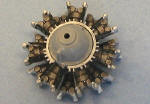 cockpit
bulkheads, which required a lot of dremeling to get the fuselage halves to come
together right. I rubber banded the fuselage and set it aside.
cockpit
bulkheads, which required a lot of dremeling to get the fuselage halves to come
together right. I rubber banded the fuselage and set it aside.
Moving on to the engine, the kit provides a good-looking Pratt & Whitney R-1820 in plastic, which I painted and installed on the cowling bulkhead, then assembled the cowling after painting the interior yellow zinc chromate.
Remembering the problems I had with the original P-36, I did not even think of
attaching the engine cowling to the fuselage. I proceeded to assemble the
wings. The earlier kit had alerted me to the extremely poor fit of the fuselage
to the upper wing, which will result in complete loss of dihedral if there is
not a lot of test-fitting and modification. This appears to be a standard
problem with all Azur kits in this scale, since the D-520 will also lose dihedral without lots of modification, and the Pacific
Coast Models Macchi C.202 (which is manufactured by MPM) has the problem even
worse.
D-520 will also lose dihedral without lots of modification, and the Pacific
Coast Models Macchi C.202 (which is manufactured by MPM) has the problem even
worse.
The engine cowling needed only a little sanding of the area that mates to the wing to get it to attach while maintaining the correct dihedral. There were huge gaps on the lower surface, which I filled with cyanoacrylate glue.
 Test fitting the fuselage to this sub-assembly of engine cowling and wing, the
fairing of the fuselage to the wing was a good 2mm too wide on both sides. I
ended up dremeling this area, with constant test-fitting, before I could finally
get the fuselage to fit to the wing properly. There were huge gaps along the
upper wing-to-fuselage joint as well as the fuselage to cowling joint. I think
this latter was exacerbated by having used the dreadful resin forward cockpit
bulkhead. I filled the gaps with cyanoacrylate, zapped it with zip kicker,
sanded it down with heavy-duty sanding sticks, then put thick coats of Mr.
Surfacer 500 on all joints of the entire model.
Test fitting the fuselage to this sub-assembly of engine cowling and wing, the
fairing of the fuselage to the wing was a good 2mm too wide on both sides. I
ended up dremeling this area, with constant test-fitting, before I could finally
get the fuselage to fit to the wing properly. There were huge gaps along the
upper wing-to-fuselage joint as well as the fuselage to cowling joint. I think
this latter was exacerbated by having used the dreadful resin forward cockpit
bulkhead. I filled the gaps with cyanoacrylate, zapped it with zip kicker,
sanded it down with heavy-duty sanding sticks, then put thick coats of Mr.
Surfacer 500 on all joints of the entire model.
With lots of sanding, re-application of more Mr. Surfacer, more sanding, and more Mr. Surfacer on the upper fuselage-to-cowling joint, the model was finally in shape and I then rescribed the panel lines that had been lost.
| COLORS & MARKINGS |
Painting:
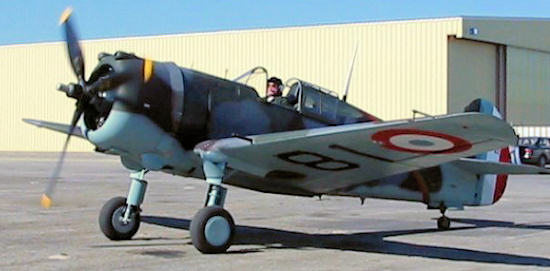 Most people assume
that the cockpit of the Hawk 75A was painted with aluminum lacquer, as was the
contemporary P-36. This turns out not to be the case, as Stephen Grey was able
to demonstrate with the restoration of the Hawk 75A-1 now owned and flown by The
Fighter Collection at Duxford. When this airplane was at Chino in 2004, I had
the opportunity to examine it closely, and was surprised by the fact the cockpit
and the scallops of the rear windows were painted interior green. I had the
opportunity to discuss this with Stephen Grey, who related that he had been
surprised to discover this when he first obtained the airplane 30 years ago. He
also obtained the painting instructions for the Hawk 75, which show that the
cockpit is to be painted “Curtiss Green,” which is merely a variety of “Interior
Green.” By this time, Curtiss had discovered that the aluminum lacquer did not
hold up that well, and had determined by 1939 that a better, tougher paint was
needed. While many photographs show the scallop area to be a very light shade,
which could be aluminum lacquer, there are also photos - such as the one of
Meslée’s airplane - which show this area in a shade darker than aluminum, but
lighter than the camouflage colors that surround it. This is exactly what one
would expect with Interior Green.
Most people assume
that the cockpit of the Hawk 75A was painted with aluminum lacquer, as was the
contemporary P-36. This turns out not to be the case, as Stephen Grey was able
to demonstrate with the restoration of the Hawk 75A-1 now owned and flown by The
Fighter Collection at Duxford. When this airplane was at Chino in 2004, I had
the opportunity to examine it closely, and was surprised by the fact the cockpit
and the scallops of the rear windows were painted interior green. I had the
opportunity to discuss this with Stephen Grey, who related that he had been
surprised to discover this when he first obtained the airplane 30 years ago. He
also obtained the painting instructions for the Hawk 75, which show that the
cockpit is to be painted “Curtiss Green,” which is merely a variety of “Interior
Green.” By this time, Curtiss had discovered that the aluminum lacquer did not
hold up that well, and had determined by 1939 that a better, tougher paint was
needed. While many photographs show the scallop area to be a very light shade,
which could be aluminum lacquer, there are also photos - such as the one of
Meslée’s airplane - which show this area in a shade darker than aluminum, but
lighter than the camouflage colors that surround it. This is exactly what one
would expect with Interior Green.
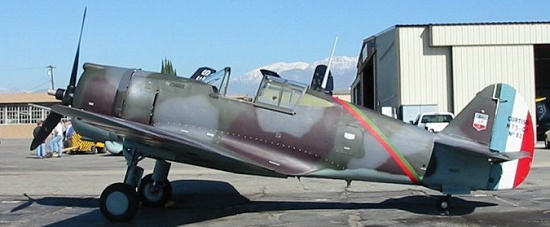 I have included
with this review two photographs taken of the restored Hawk 75 which show all
the colors used. The original colors were used as the guides for the choice of
paint in this restoration.
I have included
with this review two photographs taken of the restored Hawk 75 which show all
the colors used. The original colors were used as the guides for the choice of
paint in this restoration.
Having painted the cockpit and the scallops with Xtracrylix Interior Green, I used Xtracrylix RLM76 German Blue-Grey for the lower surface camouflage, since this closely matches the color of the restored airplane. The upper surfaces were painted with Xtracrylix “Dark Compass Ghost Grey,” “RAF Dark Green” and “Schokoladebraun” RAL 8017 Brown, each color suitably lightened and slightly “faded.” The model then received a coat of Future.
Decals:
The kit decals were used, other than for the unit marking for GC I/5, since I had a decal that was printed better and more the right size (the kit decal looks a bit small compared with the photo of the real airplane). These decals had good opacity and went on easily. When these were dry, the model received a coat of Xtracrylix Satin Varnish.
| FINAL CONSTRUCTION |
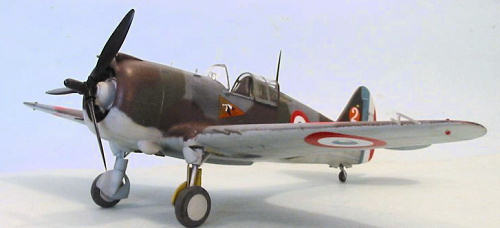 The model received two
coats of Xtracrylix Flat Varnish, which does not dry dead flat. I “dinged” the
airplane a tiny bit using a silver Farber Castell pencil. The photograph of the
airplane shows it pretty clean, so all I did was apply exhaust stains.
The model received two
coats of Xtracrylix Flat Varnish, which does not dry dead flat. I “dinged” the
airplane a tiny bit using a silver Farber Castell pencil. The photograph of the
airplane shows it pretty clean, so all I did was apply exhaust stains.
The landing gear was attached, the canopy unmasked and the slicing portion posed in the open position.
The kit only provides the U.S.-style pitot tube, so I made the French version using Evergreen plastic rod.
| CONCLUSIONS |
Not an easy kit, and not one I would recommend to anyone who does not have substantial experience with “difficult” limited-run kits. That said, the resulting model is accurate and looks very good sitting next to the Azur D-520 and the Special Hobby Morane M.S.406. I recommend it if you are interested in the airplane, but again caution that it is a kit with “issues,” though none are insurmountable.
Review kit courtesy of Hannant’s at www.hannants.co.uk
July 2006
Copyright ModelingMadness.com. All rights reserved. No reproduction in part or in whole without express permission.
If you would like your product reviewed fairly and fairly quickly, please contact the editor or see other details in the Note to Contributors.